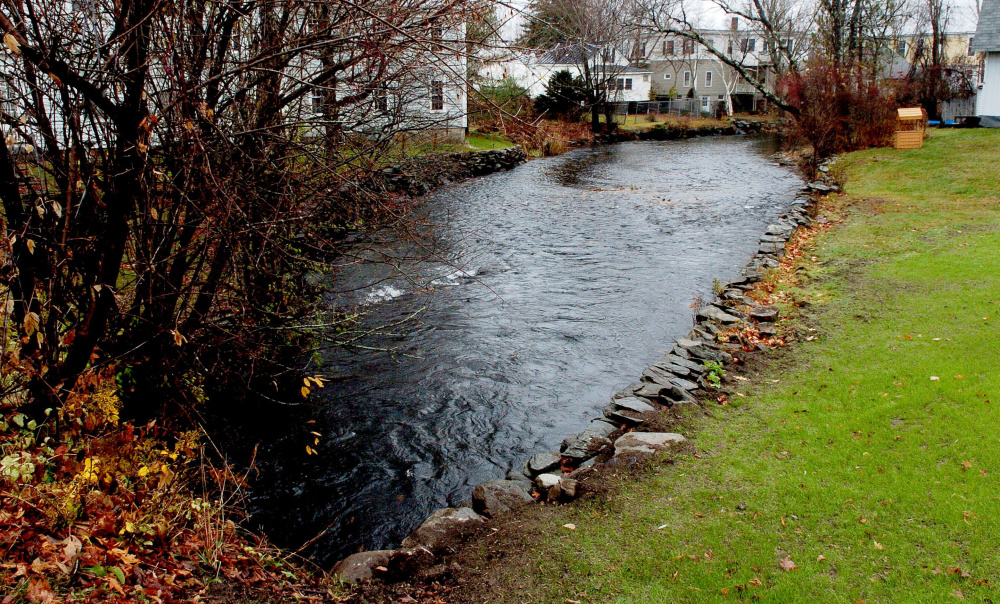VASSALBORO — A group of state and environmental organizations hoping to restore passageways for alewives throughout Maine is still being met with opposition from some residents about its latest project, the removal of the Masse Dam off Main Street, or Route 32.
The group working to remove the dam, the Alewife Restoration Initiative held a public meeting early in November as part of its application process for an individual permit to remove the structure from the Department of Environmental Protection.
ARI wants to remove the dam as part of a larger project to open up the passageway for migratory fish to get to China Lake.
Residents, however, are worried about the effect on their properties once the dam is removed, and now some are calling into question whether alewives ever made it to China Lake in the past. They say there isn’t enough evidence to conclusively prove alewives were in the area, but ARI, the state and some researchers disagree.
LOWER LEVELS, LOWER VALUES
Residents of Vassalboro who have property near the Outlet Stream or Mill Pond say that as ARI prepares to take out the dam, the removal of impoundments on the stream is lowering the water levels, threatening their property values and the land’s appeal.
But Landis Hudson, executive director of Maine Rivers, one of the organizations in ARI, said the stream level has risen again and the area is revegetating as they predicted it would.
Not all residents agree that it’s that simple.
Al Roy, who lives on South Stanley Hill Road near the Outlet Stream, said the water level has risen because the Kennebec Water District is flushing China Lake.
“Come back in a month and look at it again,” Roy said.
Matt Zetterman, director of water quality for the water district, confirmed that the district is flushing phosphorus from the lake, which affects the lake level. The weather is a factor too, he said, and the loss of water impoundments at the dam will cause levels throughout the stream and pond to vary more as the weather changes.
It’s not yet possible to say if the stream or pond will remain at low levels because much of Maine has gone through a drought this summer, Zetterman said, so there hasn’t been much chance to see how precipitation will affect it.
Hudson said the removal of the dam will help restore a “more natural flow to the stream.”
“The Mill Pond behind the sawmill is a man-made structure,” she said.
ARI is working hard on this project, she said, because of the many potential benefits a natural flow to the stream could bring. The biggest benefit is getting the alewives themselves flowing from Gulf of Maine through to China Lake to support the “food web,” as the small fish are prey for birds and larger fish.
“It’s a really rare opportunity,” she said.
ALEWIVES IN CHINA LAKE?
“It’s basically accepted that alewives made their way to any and all rivers they could get to (in Maine),” Hudson said.
In the case of China Lake, Hudson points to the Cates Farm archaeological site in East Vassalboro as one source of evidence. Archaeologists have recovered old stone fish weirs from precolonial times, a type of trap built in a waterway used to catch fish.
The archaeology report from the investigation of the Cates Farm site, which is available at centralmaine.com, says that “people camped at the right time and place to harvest the fish runs, and constructed and maintained fish weirs such as the one in Sebasticook Lake.”
The report continues on to say that the site “adds modest but important information that alewife were harvested at the site 4,000 years ago” and that it is “confirmation of the antiquity of the alewife run into China Lake.”
However, Charlie Hartman, who lives next to the former Masse Sawmill, said the report found only minimal evidence of alewives and not enough bones to determine that precolonial people were able to fish the species in that area
The archaeological dig found more than 100 calcined, or burned, bone fragments, some of which could have been alewives or small fish.
“Bone does not survive for long after burial in Maine’s acid, interior soils unless it has been calcined,” the report says. “Moreover, alewife bone is generally quite delicate, and few pieces of the skeleton would be expected to survive in archaeological context.”
Hudson said they also have found historical documentation of fish passage laws, and she said it “doesn’t make any sense to me that people would pass (that) law” if there weren’t any migratory fish in the area.
The state Department of Marine Resources agrees with Hudson as well.
MOVING FORWARD
Regardless of whether alewives were plentiful in precolonial China Lake, ARI has a permit from the Maine Department of Inland Fisheries and Wildlife to stock the lake with them. The group is also moving forward on applying to the Department of Environmental Protection for an individual permit to remove the dam after its first attempt to obtain a permit-by-rule for the project was denied.
The group held a public meeting in early November to update residents on its progress.
“There were people who are hopeful that it will help the ecology of China Lake,” she said. “Some indicated they would prefer to see more results and progress and fewer meetings.”
The hearing was part of the permit application process, which also requires the group to review the questions that were raised and send responses to the DEP.
While the group does not have a definitive timeline, Hudson said they’re hopeful they’ll have the permit in time to begin work on the dam come summer.
The project at the Masse Dam involves three components: taking down the sawmill, relocating the East Vassalboro Water Company pipes and then removing the dam. The sawmill is down and the pipe relocation is “pretty much done,” Hudson said.
“I hope that people see that as a benefit – having better infrastructure to deliver clean water to their houses,” she said.
Hudson described the feedback the group has received as a “phenomenon” that can happen when a generation or two of people don’t see an animal that was familiar to those before them.
“Each generation gets used to a lower baseline, a lower number of natural native species in the environment,” she said. “As a species disappears, it loses its relevance in society.”
Send questions/comments to the editors.





Comments are no longer available on this story